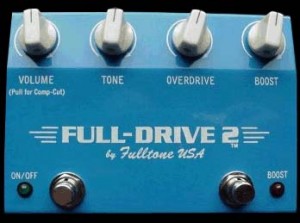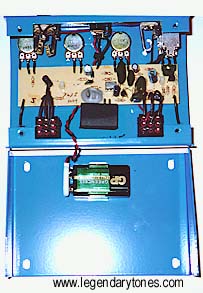 Overdrive and distortion pedals, particularly vintage models from companies such as Ibanez (check out TS-808 tube screamer prices on Ebay), Boss (OD-1 very collectable), MXR, etc., have been very popular lately. One reason is of course primarily the tone that they offer. The other, is that plain and simply, they’re just built better than what you can commercially get today. I recently opened up an old MXR distortion plus and was impressed that it had not one, but four signed signatures on it, for testing and “signing off” on the unit during various stages of construction. You don’t often see that kind of care being taken when building pedals anymore. These days, it is about getting the bottom line (i.e. the cost) down to as little as possible. Even companies such as Boss that mass-produced many units since the ‘70s, did an excellent job and the quality was top notch while the pedals were being produced in Japan. Now, is well, another story.
Overdrive and distortion pedals, particularly vintage models from companies such as Ibanez (check out TS-808 tube screamer prices on Ebay), Boss (OD-1 very collectable), MXR, etc., have been very popular lately. One reason is of course primarily the tone that they offer. The other, is that plain and simply, they’re just built better than what you can commercially get today. I recently opened up an old MXR distortion plus and was impressed that it had not one, but four signed signatures on it, for testing and “signing off” on the unit during various stages of construction. You don’t often see that kind of care being taken when building pedals anymore. These days, it is about getting the bottom line (i.e. the cost) down to as little as possible. Even companies such as Boss that mass-produced many units since the ‘70s, did an excellent job and the quality was top notch while the pedals were being produced in Japan. Now, is well, another story.
Regardless, many boutique companies have cropped up to serve the needs of discriminating musicians. Like any other company, there are good ones and not-so-good-ones out there. The good ones take pride in their work, producing products that both sound good and are well-built. The not-so-good ones may advertise as boutique to ride this recent wave of popularity but may still be using low-cost parts or use mass-produced low-quality PCBs from overseas. Fulltone is one of the good ones. In fact, they are more than just good; I’ll break from the traditional format of these reviews to say right off the top that Fulltone’s products are among the best I’ve ever played through or seen. Fulltone’s Fulldrive 2 is a good place to start for a review.
Features
The Fulltone FullDrive 2 is an overdrive unit that has controls for volume, tone, overdrive and boost. The volume control is a push/pull type that adds a compression cut feature when pulled. This is beneficial to players like myself that like the sound of the amp providing the majority of the tube compression and like to use pedals instead for their ability to add a clean boost to the overall signal. Overall boost available is a healthy 20 dB’s.
The Fulltone Fulldrive 2 is similar to the recently reviewed Hughes and Kettner TubeFactor in that it has two separate switchable gain stages so two footswitches are incorporated. One to turn the unit on and off, and the other is used to kick in the boost stage. One of FullTone’s selling features of not only this, but all other pedals in the line, is the company’s use of true-bypass switching. In short, when the unit is off, there is no tone degradation or signal loss. In fact, Fulltone manufactures the 3DPT switch themselves, which is basically a douple-pole-double-throw (DPDT) switch with an extra row of contacts that allows an LED to be designed in. In short, to make true-bypass is one thing – true-bypass with LED use is a whole different ballgame so Fulltone solved this problem by making its own.
Additional features include standard ¼” input and output jacks as well as an AC receptacle for 9 volt operation. The unit itself is housed in a 16 gauge steel enclosure with battery access available by removal of the bottom four rubber feet. And like the old MXR distortion + sitting in my studio, every Fulldrive 2 made features Mike Fuller’s signature as a final stamp of approval.
Construction
The Fulltone Fulldrive 2 is hand-built and cleanly wired. A photograph of the FullDrive 2’s inside is featured at the Fulltone website, but I’ve opted to photograph our unit as well to show that this consistency remains with production models “off the shelf” and that the Fulldrive 2 pictured at the Fulltone website is not “dolled up.” No, this is clearly NOT like the pictures you’ll see of your favorite burgers displayed at your favorite fast-food joint – what you see IS what you get. It is clear that attention to detail, component layout, and design are important to Mike Fuller. Note also that the Fulldrive 2 uses wire that is clearly more than adequate in gauge size and is of the better Teflon variety. You may think that something like wire would not be so costly, but trust me that there is a difference in price as you move up (or I should say “down” since thicker wiring is expressed in lower gauge numbers) in wiring size. The photography says it all – this is top-notch, clean construction.
While I can’t speak of a negative in terms of construction quality, I do have a suggestion for the Fulltone team for the future. The 3DPT footswitches are of excellent quality but would be even better if offered or made as the silent-switching variety (SPDT versions have been incorporated on products such as the Digitech Whammy II, obviously not the same caliber of quality though). This is obviously only a concern for studio-recording situations where there may be situations of mechanical clicking being picked up in the studio unless one is playing at a substantial volume (which is where most tube amps like to be anyhow).
Sound
Remarks have been made about the FullDrive 2 being similar to a Tube Screamer. I like to think of the Fulldrive II as taking over from where the Tube Screamer left off but it also adds much more versatility. In comparing a TS-808 circuit to the FullDrive 2 using both as a clean boost, they both responded similarly but I do have to say that the FullDrive 2 was even more responsive to the touch, especially with the compression cut feature activated. The FullDrive 2 also provides much more boost, a feature that even heavy metal/hard rock players will love when running in the front of master volume Marshall amps for example. I tried this on my own ’76 master volume (the one photographed for the LegendaryTones.com logo) with the preamp cranked to full on the Marshall. This definitely turned into metal territory. Great tone, very smooth – it was the Marshall, but just more of it! And this tone has much more character than the Mesa-Boogie “over-gained” Rectifiers you hear on the radio as the Marshall still had a sense of dynamics and “feel”.
For blues, clean-boosting with the FullDrive 2 and a Strat allowed the Strat to really sing. Playing through a Fender as well as an old Marshall Super Lead yielded great results. The Fulldrive 2 helped provide a beautiful and very sweet sound. According to Fulltone, the Fulldrive 2 gets its natural sound through the use of Asymmetrical Clipping and Fuller’s own “Feedback Loop” circuit that is a way of creating distortion high in even ordered harmonics like a Class A tube amp. I have to say I was convinced.
When using the unit as an overdrive, I put it on the front end of a ’72 Hiwatt DR-103 set clean. The overdrive was smooth and the tone control (voiced like a “presence” control according to Fulltone) worked well in all settings. This is not a one or two-setting type of tone control, but one that provides usable brilliance when turned up, or softens the edges when backed off. Running this quality overdrive through a quality amp such as the Hiwatt made it so I could honestly say that I could not tell that this was not a tube device. Because the dynamics were there and the overall response and tone was smooth and rich, the Fulldrive 2 worked very well in its role as a sole supplier of overdrive. In fact, I’ve made the argument before as well that the primary source of gain that sounds pleasing to the ears is always that which is supplied by the power tubes, although there’s nothing wrong with preamp-tube based devices. Having said this, Fulltone is planning a tube-based distortion unit that will be available later this year and we hope to be able to get our hands on one when they become available. If it’s consistent with Fulltone’s other products, it should be a killer.
The boost control adds another dimension in tonal versatility. When using the Fulldrive 2 in front of the Hiwatt, in essence I had a three-channel setup; a clean sound when bypassed, overdrive when activated and a more-sustained overdrive when activating the boost switch. As a standalone device, the FullDrive 2 used in this fashion should satisfy rock and blues players alike, however this is not a “super-gain” type of device. That is not the unit’s intention and those looking for that tone all in a box should look elsewhere. The better method in my opinion is to simply use it to boost an already-good tube amp such as the Marshall master volume models. In that fashion, you’ll get all the gain you’ll need – with a quality tone and you’ll then avoid getting the crappy “distortion-box sound”.
It takes time to explore the different sonic possibilities out of the Fulldrive 2 especially since the changes are very dramatic when using the compression cut feature. However, the versatility and the combinations of sounds available make it worthwhile to explore.
Conclusion
The Fulltone Fulldrive 2 was a pleasure to use and listen to. Its quality construction is second-to-none, its tones are stunning and almost any player can benefit from using one. At $199, it’s not a “cheap” pedal, but you don’t buy a Fulldrive 2 if you want cheap. You buy it if you want a high-quality tone-enhancer that will work with you, not against you. If you’ve been searching for that special something that will “just give you a little bit more” out of your setup, or if you’re starting from ground zero and want a flexible two-channel overdrive, look no further. Visit Fulltone on the web at www.fulltone.com.
Best pedal I´ve ever had the pleasure of using. Turns any amp into a multi-tone beast.
Adds wonderfull sustain and extra harmonics to your clean sounds.
The boost switch is so sweet – it´s louder and fuller but the tone stays true.
Definitely not a distortion pedal – but makes any distortion or clean channel in your amp really come to life.
Highly recommended for all genres.